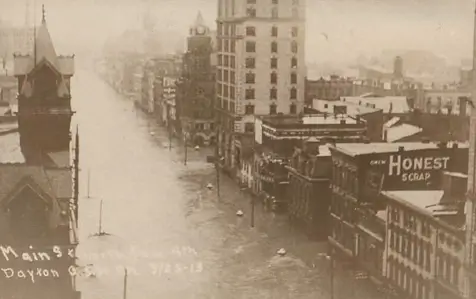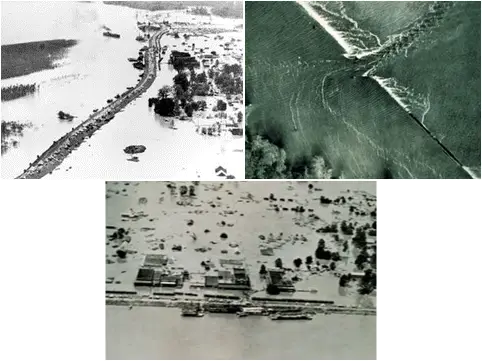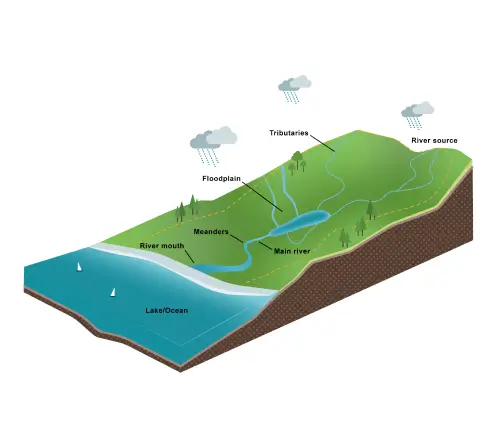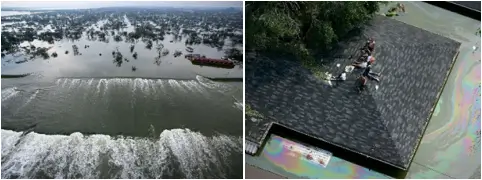
LEVEE BASICS
History of Levees
Early America
People have long made their homes near bodies of water that provide access to drinking water, food, nutrient-rich soil, and sources of transportation, power, and natural beauty. While there are numerous benefits to living in areas near water, there are also challenges when water collects and overruns streambanks or coastlines, flooding nearby areas.
Levees have been built throughout the U.S. to keep water away from a specific area. Early Indigenous Americans built raised earthen structures along the Ohio and Mississippi Rivers to create safe havens from flooding. Local and regional entities and farmers constructed levees during this time to keep water away from communities or farmland.
These early levees were constructed in a rudimentary manner and without the benefits of modern engineering and science practices. In addition, no single entity was responsible for levees, every levee built was a little different, and many failed.
Early 20th Century
Several devastating and costly floods during the 20th century led to changes in how levees were built and who was involved.
The Great Flood of 1913
The Great Flood of 1913 occurred in March after major rivers in the central and eastern U.S. flooded. The Ohio River and its tributaries overflowed their banks and submerged cities such as Fort Wayne, Cincinnati, Columbus, and Indianapolis. Dayton, Ohio was also hit hard; the Miami River rushed into the downtown area, submerging parts of the town in 20 feet of water. It is estimated that the Great Flood of 1913 killed more than 1,000 Americans.
Image: Main Street in Dayton, Ohio flooded during the Great Flood of 1913.

From the late 1890s until 1917, all the country’s major river basins experienced periodic flooding, including the Mississippi, Ohio, and Sacramento Rivers. The destruction resulting from these floods led to Congress passing the Flood Control Act of 1917. Provisions of the 1917 Act were designed to reduce flood damage along these rivers. Specifically, it authorized “flood control” work outside the Mississippi Valley, directed local communities to contribute half the cost of levee construction projects, and required these communities to maintain levees once construction was complete.
The U.S. Army Corps of Engineers was an important early partner and played a role constructing dams and levees during this time. Many states and communities also established flood commissions or conservancies during this time and constructed dams and levees on their own in an aim to avert similar flood catastrophes in the future.
The Great Mississippi River Flood of 1927
The Mississippi River flood of 1927 is considered one of the worst natural disasters in the history of the U.S. After several months of heavy rain along the Mississippi, most of the levees along the waterway collapsed. This left a widespread area submerged, up to 30 feet deep in some areas, and water did not fully recede for several months. More than 23,000 square miles of land were submerged, hundreds of thousands of people were displaced, and some 250 people died. This disaster disproportionally impacted African Americans and contributed to many people migrating to cities in the north.

Flooding on the Mississippi in 1927 and a disastrous nationwide series of floods in 1935 and 1936 spurred Congressional response and resulted in the Flood Control Acts of 1928 and 1936. These Acts established federal interest in the design and construction of flood structures such as dams, levees, and channel improvements.
The 1928 Act authorized the U.S. Army Corps of Engineers to design and construct “flood control” projects and emphasized the requirement for local communities to perform post-construction operation and maintenance for levees. The 1936 Act authorized the U.S. Army Corps of Engineers and other agencies to construct flood structures such as levees and floodwalls and perform channel improvements. Levees along the Mississippi River near Baton Rouge and New Orleans, Louisiana were constructed because of this act, as well as some dams.
Many structures built by the federal government during this time were designed to withstand the “standard project flood,” the largest reasonable flood that could be expected (usually at 500 to 1,000-year frequency flood).
Early Floodplain Management
During the 1800s and early 1900s, the U.S. approached water and flooding as something that could be controlled. Early nomenclature around dams and levees aligns with this philosophy, and most projects authorized by Congress and built during this time are referred to as flood control projects. Dams and levees were used to control how water collected and moved throughout communities in the U.S.
However, repeated flooding and failures of this infrastructure over time led to an evolution in thinking and acceptance that water and flooding cannot be fully controlled. Dams, levees, and similar structures provide enormous benefits by reducing the frequency and intensity of floods, but the risk of flooding cannot be eliminated. A combination of measures is best for addressing flooding. This combination of measures is often referred to as flood risk management or floodplain management and focuses on wise and beneficial use of areas that naturally flood. Read more about floodplain management here.

The science and engineering used to understand water and design and build levees evolved during this time. Due to its role constructing dams and levees nationwide, the U.S. Army Corps of Engineers established early design and construction criteria for levees, based primarily on experience constructing the levee systems along the Mississippi River. This early experience and guidance laid the groundwork for approaches used to design, modify, and construct levees today.
Influence of the National Flood Insurance Program and Cost-share Requirements
In 1968, Congress enacted the National Flood Insurance Act creating the National Flood Insurance Program to provide affordable flood insurance and promote sound floodplain management practices. The National Flood Insurance Program is a voluntary program administered by the Federal Emergency Management Agency (FEMA) and enables property owners in participating communities to purchase flood insurance to help mitigate against flood losses, while requiring state and local governments to enforce floodplain management ordinances that reduce future flood damages. Anyone in a participating community may purchase flood insurance, but as a result of lack of community participation in the program along with continued flood events, Congress later enacted the Flood Disaster Protection Act of 1973 to establish mandatory flood insurance for buildings with federally backed mortgages in areas identified as special flood hazard areas (SFHA).
A special flood hazard area is the land area that has a 1-percent chance of flooding every year, sometimes called the base flood. Within the special flood hazard areas, the National Flood Insurance Program also requires all new or substantially improved buildings be constructed at or above the elevation of the 1-percent annual chance of flooding.
In 1986, FEMA established procedures for the recognition of levee systems and their influence on the identification of special flood hazard areas. Communities or parties seeking recognition of a levee system as part of the National Flood Insurance Program maps must provide data and documentation in accordance with program requirements, detailed in 44 Code of Federal Regulation (CFR) 65.10. Once criteria for 44 CFR 65.10 are met, a levee is mapped as accredited and generally, the area behind an accredited levee system is not designated as a special flood hazard area. Therefore, there are no building requirements for floodplain management and no mandatory insurance purchase requirement for structures with federally backed mortgages behind accredited levees. As a result, seeking accreditation of levees became an economic incentive for many communities.
Did You Know?
A special flood hazard area (SFHA) is the land area that has a 1-percent chance of flooding every year, sometimes called the base flood. These areas are shown on flood hazard boundary or flood insurance rate maps. These maps are used as regulatory products and indicate an area where floodplain management regulations are required as is the purchase of flood insurance. However, these maps are not representative of all flooding that can occur. FEMA and other federal partners continue to work to create new and updated mapping methodologies that more accurately represent and display flood hazards. Read more about these efforts here.
The Water Resources Development Act of 1986
The Water Resources and Development Act of 1986 required additional financial contribution from locals to cost share projects constructed by the U.S. Army Corps of Engineers including cost share, provision of easements, rights of way, and real estate. Project cost-share sponsors were also responsible for providing all operations, maintenance, repair, rehabilitation, and replacement after the project was completed.
These additional financial burdens on local communities made affordability of new levees and repairs of existing levees a larger concern. As a result, many communities advocated for levees to be constructed to meet 44 CFR 65.10 (1% annual chance design) to obtain what was perceived as the minimum federal required level of design for levees that provided the economic benefits of unrestricted development in the floodplain behind the levee and no flood insurance requirements. The requirements for an accredited levee system in 44 CFR 65.10 became a de facto, unintentional national standard for levees.
Early 2000s
In 2005, there was heightened public awareness of levees as a result of Hurricanes Katrina and Rita. Economic damages associated with Hurricane Katrina exceeded $200 billion and resulted in the loss of 1,800 lives. These events also prompted agencies such as the U.S. Army Corps of Engineers to take a closer look at how the agency manages levees. Soon after, Congress passed the National Levee Safety Act (Water Resources and Development Act of 2007, Title IX), which called for the development of recommendations for a National Levee Safety Program.
Hurricane Katrina
Hurricane Katrina first made landfall in south Florida in late August. The system stalled over the Gulf of America and gained enough strength to make landfall in Louisiana as a category 4 storm, 60 miles southeast of New Orleans. The storm slowly moved toward New Orleans, dropping more rain than a fast-moving system would have, and bringing 125 mph wind and 28-foot storm surge, devastating much of Biloxi and Gulfport, Mississippi. The levee systems in New Orleans were overwhelmed during the storm. Breaks in the line of defense left 80 percent of New Orleans inundated, with floodwaters reaching 10 to 15 feet in some areas; water did not recede for weeks. Hurricane Katrina and its aftermath killed more than 1,800 people and is one of the costliest U.S. hurricanes on record.

Today
A nationwide network of nearly 7,000 levees is used to help manage the impacts of flooding to 17 million people and $2 trillion in property. Levees continue to have a key role in the vitality of communities across the U.S.
Over the past 15 years, many advancements have been made with levees. The National Levee Safety Program, currently under development, offers an opportunity to converge and evolve the experience, technology, and information to help preserve the levees that so many communities depend on. The National Levee Safety Program is designed to support all levees, and once established will provide a consistent framework to reduce the impacts of flooding and improve community resilience in areas behind levees. For more information about the program, visit www.leveesafety.org.
Next Up
Learn about managing levees.